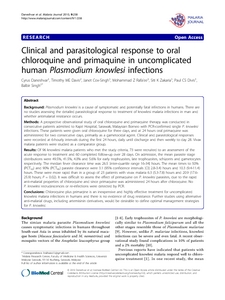Daneshvar, C; Davis, TM; Cox-Singh, J; Rafa'ee, MZ; Zakaria, SK; Divis, PC; Singh, B
(2010)
Clinical and parasitological response to oral chloroquine and primaquine in uncomplicated human Plasmodium knowlesi infections.
MALARIA JOURNAL, 9 (238).
ISSN 1475-2875
https://doi.org/10.1186/1475-2875-9-238
SGUL Authors: Cox-Singh, Janet
![[img]](https://openaccess.sgul.ac.uk/784/1.hassmallThumbnailVersion/1475-2875-9-238.pdf)  Preview |
|
["document_typename_application/pdf; charset=binary" not defined]
Published Version
Download (313kB)
| Preview
|
Abstract
BACKGROUND: Plasmodium knowlesi is a cause of symptomatic and potentially fatal infections in humans. There are no studies assessing the detailed parasitological response to treatment of knowlesi malaria infections in man and whether antimalarial resistance occurs.
METHODS: A prospective observational study of oral chloroquine and primaquine therapy was conducted in consecutive patients admitted to Kapit Hospital, Sarawak, Malaysian Borneo with PCR-confirmed single P. knowlesi infections. These patients were given oral chloroquine for three days, and at 24 hours oral primaquine was administered for two consecutive days, primarily as a gametocidal agent. Clinical and parasitological responses were recorded at 6-hourly intervals during the first 24 hours, daily until discharge and then weekly to day 28. Vivax malaria patients were studied as a comparator group.
RESULTS: Of 96 knowlesi malaria patients who met the study criteria, 73 were recruited to an assessment of the acute response to treatment and 60 completed follow-up over 28 days. On admission, the mean parasite stage distributions were 49.5%, 41.5%, 4.0% and 5.6% for early trophozoites, late trophozoites, schizonts and gametocytes respectively. The median fever clearance time was 26.5 [inter-quartile range 16-34] hours. The mean times to 50% (PCT50) and 90% (PCT90) parasite clearance were 3.1 (95% confidence intervals [CI] 2.8-3.4) hours and 10.3 (9.4-11.4) hours. These were more rapid than in a group of 23 patients with vivax malaria 6.3 (5.3-7.8) hours and 20.9 (17.6-25.9) hours; P = 0.02). It was difficult to assess the effect of primaquine on P. knowlesi parasites, due to the rapid anti-malarial properties of chloroquine and since primaquine was administered 24 hours after chloroquine. No P. knowlesi recrudescences or re-infections were detected by PCR.
CONCLUSIONS: Chloroquine plus primaqine is an inexpensive and highly effective treatment for uncomplicated knowlesi malaria infections in humans and there is no evidence of drug resistance. Further studies using alternative anti-malarial drugs, including artemisinin derivatives, would be desirable to define optimal management strategies for P. knowlesi.
| Item Type: |
Article
|
| Additional Information: |
© 2010 Daneshvar et al; licensee BioMed Central Ltd. This is an Open Access article distributed under the terms of the Creative Commons Attribution License (http://creativecommons.org/licenses/by/2.0), which permits unrestricted use, distribution, and reproduction in any medium, provided the original work is properly cited. |
| Keywords: |
Administration, Oral, Adult, Antimalarials, Borneo, Chloroquine, Drug Therapy, Combination, Female, Follow-Up Studies, Humans, Malaria, Male, Middle Aged, Parasitemia, Plasmodium knowlesi, Primaquine, Prospective Studies, Treatment Outcome, Science & Technology, Life Sciences & Biomedicine, Parasitology, Tropical Medicine, FALCIPARUM-MALARIA, VIVAX MALARIA, THERAPEUTIC RESPONSES, ANOPHELES-LATENS, MALAYSIAN-BORNEO, RHESUS-MONKEYS, ANTIMALARIAL, DRUGS, TRANSMISSION, SENSITIVITY |
| Journal or Publication Title: |
MALARIA JOURNAL |
| ISSN: |
1475-2875 |
| Related URLs: |
|
| Web of Science ID: |
WOS:000282416400004 |
| Dates: |
| Date |
Event |
| 2010-08-19 |
Published |
|
  |
Download EPMC Full text (PDF)
|
 |
Download EPMC Full text (HTML)
|
| URI: |
https://openaccess.sgul.ac.uk/id/eprint/784 |
| Publisher's version: |
https://doi.org/10.1186/1475-2875-9-238 |
Statistics
Item downloaded times since 30 Apr 2012.
Actions (login required)
 |
Edit Item |



